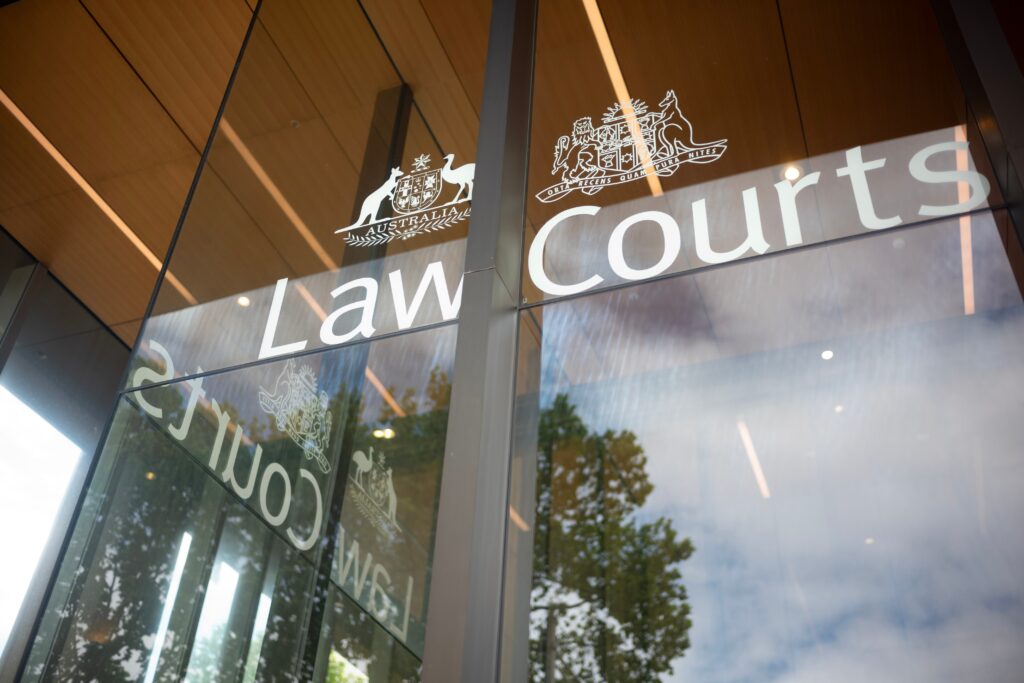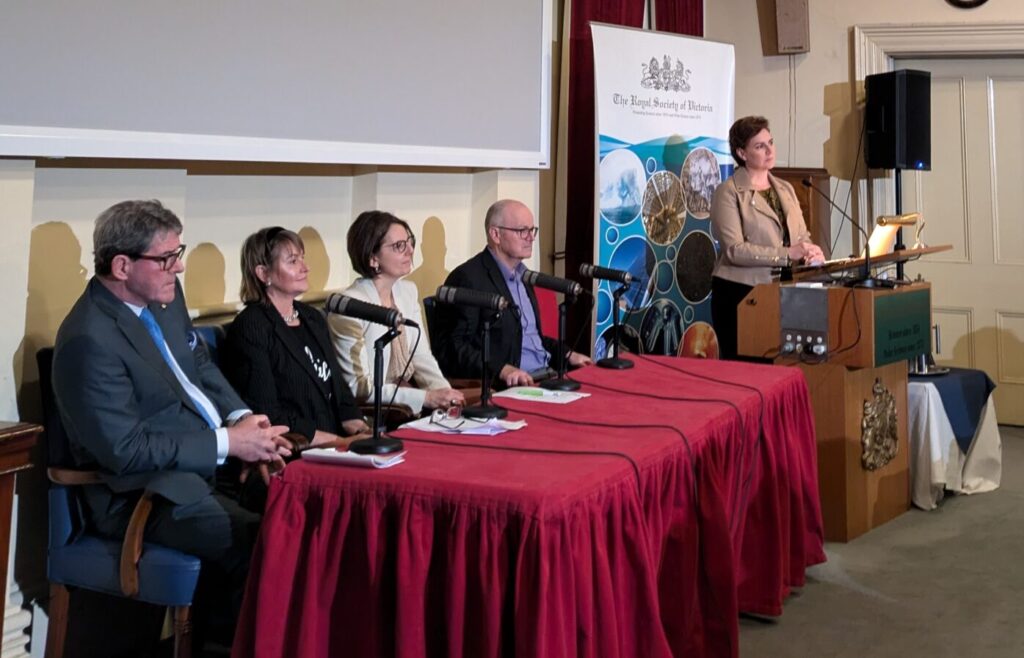Science, Media, and the Law: Lessons from the Kathleen Folbigg Case
By Dr Catriona Nguyen-Robertson MRSV
Senior Editor, Science Victoria

Sometimes it might feel like the world is stacked against you. In the case of Kathleen Folbigg, the entire judicial process was stacked against her.
She was wrongfully convicted in 2003 of murdering her four infant children over a ten-year period. She spent decades behind bars, accused of harming the children that she so tragically lost and labelled as Australia’s worst female serial killer.
The system was against her from the beginning. Her father was a criminal, murderer, and savage of the underworld. She was portrayed as her “father’s daughter”.
At the time of her trial, Kathleen had little chance of a ‘not guilty’ verdict. Scientific and medical evidence suggesting that Kathleen’s daughters died of natural causes was dismissed, and her words were taken out of context.
“Team Folbigg” faced many barriers to getting complex science considered as robust legal evidence in the Australian judicial system. But after a 20-year legal battle, her name was cleared. She was pardoned and released from prison in June 2023, and exonerated – her convictions finally quashed – in December.
Why was she convicted in the first place?
Kathleen had her first child in 1989, who passed away 19 days later. Neither of her next two children survived beyond a year. The deaths of her three infants were attributed to sudden infant death syndrome, or SIDs, an umbrella term encompassing sudden, unexplained deaths of seemingly healthy babies.
Kathleen’s fourth child, Laura, passed away at almost 19 months old. Even Laura’s death was initially determined to be medical at first…until the autopsy doctor learned of the deaths of Laura’s siblings. He notified the police, believing that smothering was a possibility.
Instead of being allowed to mourn the loss of her fourth child in a decade, Kathleen faced the full brunt of the NSW police, the judicial system, and a hostile Attorney General.
The conviction relied on Meadow’s law: that “one infant death is a tragedy, two is suspicious, and three is murder”. Ironically, the year after Kathleen’s conviction, the reputation of retired paediatrician Roy Meadow, who first stated this, was severely damaged after it came to light that his role as an expert witness led to the wrongful conviction of several mothers who had been accused of killing their babies.1
In the case of the four Folbigg children, Meadow’s law suggested that someone was to blame. Responsibility was placed solely on Kathleen as she had been the only one in the presence of each child when they died or had been the one to find them deceased. All evidence was circumstantial, and almost no scientific evidence was asked for or considered.
The science that set Kathleen free

Immunologist Professor Carola Vinuesa was pulled into the Folbigg case in 2018. She read the medical files of the deceased children and saw signs of underlying illnesses in all four, such as respiratory infections. Just one month earlier, she and colleagues had identified a rare genetic mutation that appeared to explain four mysterious infant deaths in a family in Macedonia.2
More than one-third of sudden deaths in children can be explained by genetic conditions.2 Furthermore, studies over the years have shown that siblings of infants who have died of SIDS have a fourfold greater risk of dying suddenly.3 Carola therefore became quickly convinced of Kathleen’s innocence.
Carola’s team collected a DNA sample from Kathleen. The sample revealed a mutation in a gene, CALM2, that encodes the calmodulin protein, whose malfunction has been implicated in heart disorders and infant deaths. After testing existing blood samples from the Folbigg children, it was clear that the children had indeed inherited the mutation.
This was a new area of research. At the time of the first judicial inquiry into Kathleen’s convictions, there was no definitive experimental evidence. Carola presented the prediction that the mutation likely caused the children’s deaths, but there was still a level of uncertainty.
Instead, the evidence that was used to make a decision at the hearing were Kathleen’s journals. Kathleen had been journalling since her teens and continued as a grieving mother to process her trauma. The journals were analysed by a legal team – never a psychologist or psychiatrist – and the entries were viewed as evidence to admissions of guilt and used to secure Kathleen’s conviction.
Carola then reached out to cardiologists, and one, Professor Peter Schwartz, had overseen a case that mirrored this situation: a healthy mother with a similar calmodulin mutation had two children suffer heart attacks and one dying.2
Carola, Peter, and other scientists continued their investigations. They compiled scientific evidence, including publishing studies suggesting the CALM2 mutation was indeed detrimental to cardiac health and data showing that both Kathleen’s sons had mutations in another gene known to cause lethal epilepsy in mice.4
The tide began to turn.
Changing Kathleen’s “fate”
While ultimately successful, the voice of scientific expertise was difficult to establish in this emotionally charged, challenging case. It required a sustained campaign by a team of Kathleen’s close friends, philanthropists, scientists and legal professionals championing the cause.
The team of scientists had to work tirelessly to amass genetic evidence that explained the children’s deaths – and ensure that this evidence was listened to.
Having clear scientific evidence now published in peer-reviewed journals supporting Kathleen’s innocence, 100 eminent scientists from around the world, medical practitioners, and other prominent Australians signed a petition calling for Kathleen’s immediate pardon. The Australian Academy of Sciences also backed the plea.
While more and more high-profile and influential people were being drawn to the case, the team waited months without a decision from the Attorney General.
If taxpayer money was to be spent on a second inquiry, then Team Folbigg needed to change the narrative around Katheleen from “murderer” to a mother wrongly incarcerated.
With public opinion overwhelmingly shaped by the media, they launched a massive media campaign. Kathleen’s story was all over main news coverage both internationally and locally. This eventually applied enough pressure on the Attorney General and Director of Public Prosecutions to open the doors again for another inquiry.
One of Kathleen’s high-profile supporters was businessman Peter Yates, who helped raise around $200,000 from the business community to finance transport and accommodation for the legal team and scientific expert witnesses. The Academy of Sciences assisted with recruiting the right experts from around the world, and Peter wanted to ensure that they could make the inquiry in-person to do Kathleen’s story – and the science – justice.
The scientist experts at Kathleen’s second inquiry in 2022 were put through six hours of questioning. Unlike in the first inquiry, the questioning was not hostile and dismissive. According to Anna-Maria Arabia, Chief Executive at the Australian Academy of Science, their answers were “just great scicomm”. The science was heard, and there was now reasonable doubt that Kathleen had killed her children.
Creating a more science-sensitive legal system

To this day, there are hundreds of mothers in court cases, accused of inflicting harm to their children, when the cause is most likely rare genetic disorders that we do not yet know much about. Some have even sought Carola’s help after this case.
Science can now play a greater role in explaining sudden deaths that seem suspicious. There may be other genetic diagnoses that may have been missed. There needs to be more collaboration between the scientific world and the legal profession.
According to Anna-Maria, the problems in Kathleen’s case present three opportunities for law reform:
- A reliability standard for evidence presented. Not anything can be presented as “evidence” – especially the diaries of a grieving mother that were not even looked at by a psychologist or psychiatrist.
- A way to select independent and reliable experts – the role that the Australian Academy of Sciences played in this case.
- Mechanisms to review appeals so that new scientific evidence can be heard in cases as it emerges. Two decades ago, we did not know of the calmodulin mutations that likely led to the deaths of Kathleen’s children – but there is no question that it should have been considered when it did come to light.
It is also important for experts to be briefed or trained in science communication so that they can present complex scientific evidence to judges and juries – and the wider community, who form public opinion. For science to have influence in court proceedings, it needs to be understood.
Kathleen should have never been charged. There had been no evidence to implicate her. There had been reports of her infants’ poor health. To put a grieving mother on trial for the murder of her children was unjust.
Her story is one of science and scientists fighting to be heard in a legal system that is not equipped to keep up with the pace of research. Australia needs to ensure that this doesn’t happen again to others.
This article follows a presentation by Peter Yates (Board Chair in Financial Stewardship, Science Engagement and Not-for-Profit), Anna-Maria Arabia (CEO, Australian Academy of Science), Professor David Balding (Statistical Geneticist), and Tracy Chapman (Friend and Advocate to Kathleen Folbigg). Presented as part of National Science Week and co-hosted by the Australian Academy of Technological Sciences and Engineering (ATSE), Royal Society of Victoria and the Australian Academy of Science. Watch the full discussion here: youtube.com/watch?v=7Mg0KHon6RU
References:
1. Dyer, O. (2004). Meadow faces GMC over evidence given in child death cases. BMJ, 328(7430), 9–9. doi.org/10.1136/bmj.328.7430.9
2. Travis, J. (2023, June 6). How a geneticist led the effort to free a mother convicted of killing her kids. Science. Science Insider. www.science.org/content/article/how-geneticist-led-effort-free-mother-convicted-killing-her-kids
3. Glinge, C., et al. (2023). Risk of Sudden Infant Death Syndrome Among Siblings of Children Who Died of Sudden Infant Death Syndrome in Denmark. JAMA Network Open, 6(1), e2252724. DOI: 10.1001/jamanetworkopen.2022.52724
4. Brohus, M., et al. (2020). Infanticide vs. inherited cardiac arrhythmias. EP Europace, 23(3), 441–450. DOI: 10.1093/europace/euaa272






